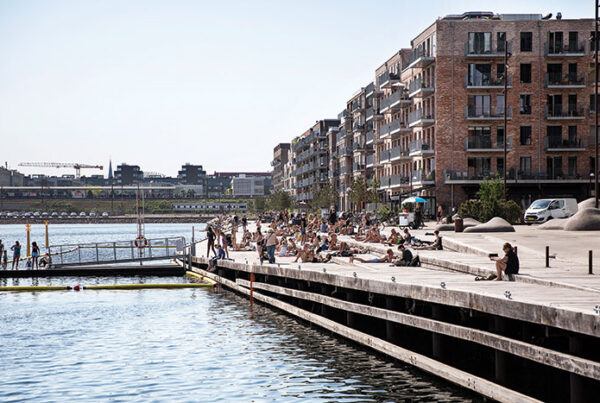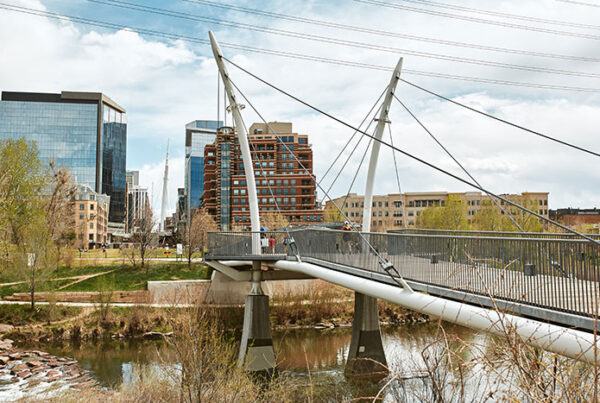A floodplain buyout is a property acquisition in which a government agency purchases private property, demolishes any structures on it, and preserves the land as open space, as an area that absorbs excess water, or for both purposes. Although buyouts are currently almost entirely used for residential properties in the United States, the increased use of the approach in urban areas has important implications for all real estate types and for future land use regulation and climate resilience strategy.
As the impacts of climate change continue to intensify, households and business owners are increasingly looking to move out of harm’s way. A new ULI report, On Safer Ground: Floodplain Buyouts and Community Resilience, explores one method to facilitate these relocations: floodplain buyouts. Drawing on the insight of ULI member experts and other leaders in the field, the report looks at how buyouts are likely to increasingly affect the real estate sector. Local governments across the United States are increasingly turning to buyouts as one strategy to reduce flood risk, offer relief to residents, and potentially improve access to open space in urban areas.
The year 2020 was a record-breaking one for flood events in the form of severe storms and hurricanes in the United States, alone accounting for 22 billion-dollar events and over $95 billion in damage. Hurricanes, severe storms, and floods were responsible for roughly 80 percent of weather disaster costs.
A floodplain buyout is one method to address these coastal hazards. A buyout is a property acquisition in which a government agency purchases private property, demolishes any structure or structures on it, and preserves the land as open space, as an area that absorbs excess water, or for both purposes.
A buyout strategy is distinctive from other approaches to mitigate flood risk in that it fully removes a property from future damages. “Buyouts are the only approach that achieves a zero risk level,” says report adviser Michael Bloom, manager of the sustainability practice at R.G. Miller Engineers and a ULI member.
“Buyouts break the cycle of flood damage and recovery,” says Fawn McGee, director of the New Jersey Blue Acres Program, which has acquired 760 properties through buyouts.
On Safer Ground looks at best practices and models for implementing floodplain buyouts. They include the following:
- Engaging with communities equitably. To create a voluntary buyout program and vision toward implementation of future plot uses, it is best to clearly communicate and engage with residents. This includes prioritizing at-risk communities equitably, maintaining transparent communication and outreach, ensuring that all aspects of the buyout program remain voluntary, bringing in independent third parties throughout the process to enhance community trust and provide objective analysis, and offering full-cycle support and “wraparound services.”
- Seeking perennial and sustainable funding streams to work with homeowners on sensible, compassionate buyout plans. Emerging partnership models and funding mechanisms can offer strategies to create funding availability and advance buyout projects before a disaster strikes.
- Leveraging the buyouts for enhanced open space. Bought-out properties, considered either as individual parcels or at larger, multiparcel scales, can offer a range of benefits to both the ecosystem and community residents, with an eye toward flood resilience, including offering aesthetic value, restoring ecological function, creating natural flood buffer zones, and offering recreation and education opportunities.
Though buyouts offer an important opportunity to help households in harm’s way, their use suffers from many constraints, notably buyouts may be difficult to coordinate, are costly to execute, and are challenging to deliver in urban or high-density development contexts.
Moreover, without considered intervention, buyouts can also perpetuate existing inequitable development practices. For instance, buyout programs should offer relocation support so residents are not priced out of areas where they have built their social support networks. As an example, the New Jersey Blue Acres Buyout Program provides social and relocation assistance to property owners and tenants in flood-prone areas. After Superstorm Sandy ravaged the state and destroyed hundreds of homes, the Blue Acres staff ramped up its work to counsel, advocate for, inform, and listen to homeowners who may be considering a buyout, and provide support for relocation assistance to property owners and tenants in flood-prone areas.

Nashville’s Riverfront Park. (Flickr/Tyler Neu)
The report also gives examples of communities that have successfully implemented floodplain buyouts and leveraged purchased sites for open space or other community amenities. In downtown Nashville, Riverfront Park transformed buyout properties into a park offering flood mitigation and recreational amenities. Located on previously industrial land next to the Cumberland River that was bought out following a devastating 1,000-year flood event in 2010, the park is designed to mitigate flooding and provide a dynamic public gathering space.
“The downtown riverfront park utilizes multiple low-impact development strategies on a brownfield site, including bioretention, pervious pavements, green roof, urban tree cover, and a 375,000-gallon rainwater harvesting cistern buried under a wing of the amphitheater for park irrigation,” says Kim Hawkins, lead landscape architect on the Riverfront Park project and founding principal of Hawkins Partners, a landscape architecture and planning firm based in downtown Nashville. She is also chair of ULI Nashville.
In booming Mecklenburg County, home of Charlotte, North Carolina, the county and six surrounding towns created a joint Storm Water Services Utility, which has funded a Floodplain Buyout Program that has acquired over 400 properties and returned over 180 acres of floodplains to natural land and open space.
“We considered various structural approaches to reduce flood damage, but we came to the realization that because of where our floodplains are, it was time to start un-developing,” says Tim Trautman, flood mitigation program manager of Charlotte-Mecklenburg Storm Water Services.
This proactive approach to land use has saved taxpayers over $25 million in property damages since 1999. In addition, having stable, annual revenue streams has enabled the city to plan buyouts that make new, coordinated public places more feasible.
Harris County, Texas, home of Houston, has faced the issue of catastrophic floods for decades. In response, the Harris County Flood Control District mounted the voluntary Property Acquisition Program to identify property in likely inundation paths and work with residents. It finds success in two approaches: delivering public spaces that control flooding impact and executing buyouts that rescue homeowners.
Through comprehensive planning before and after buyouts, the district can develop sites with attractive public uses once the district has assembled critical contiguous parcels. James Wade, who runs the Voluntary Property Acquisition Department of the Harris County Flood Control District, notes that this assembly can take years. “Once we have contiguous properties, we look at land use,” he says. “Something may be usable as public space.”
Although buyouts are led by the public sector, practitioners have shown increased interest in identifying strategies for better collaboration or partnership with the private sector and to play a role in preparing for increasingly destructive and frequent flooding events.
Tools that municipalities are beginning to explore for buyouts include the following:
- Property transfer/transfer of development rights (TDR) programs, create market incentives to move development away from areas where it is discouraged and to areas where development is preferred, known as receiving areas.
- Land banks are entities, usually facilitated by nonprofit or municipal or other governmental entities, that convert (usually) vacant, abandoned, and foreclosed properties for new uses. A land bank can be a productive vehicle to facilitate the acquisition, management, and disposition of parcels until a new use is identified.
- Leasebacks, also called sale-leasebacks, allow local governments to purchase property and rent it to either the original owner or a third party to generate the revenue needed to cover the cost of the purchase. Leasebacks also offer a more flexible strategy for acquiring at-risk properties, which may minimize negative circumstances by offering additional time to relocate.
- Community land trusts (CLTs) are nonprofits that can gain control of land to address a community need over a long period of time. CLTs can offer a community-centered, flexible model and are being used to support relocation from vulnerable places and deliver needed housing in receiving communities.
- Value capture models may offer an opportunity to develop partnerships that, through the installation of green infrastructure and park or open-space amenities, capture value from surrounding properties benefiting from the new amenity.
Buyouts may be leveraged more in the future, including in structures with active partnership from the real estate sector, as communities and households increasingly recognize the impacts of climate change and consider migration to safer ground.
Real estate and land use practitioners have an opportunity to equip themselves with knowledge on best practices and empower their communities and partners to develop equitable and multi-benefit buyout programs—before the next flood.
ULI members can access copies of the full report, and many other reports, at knowledge.uli.org.




